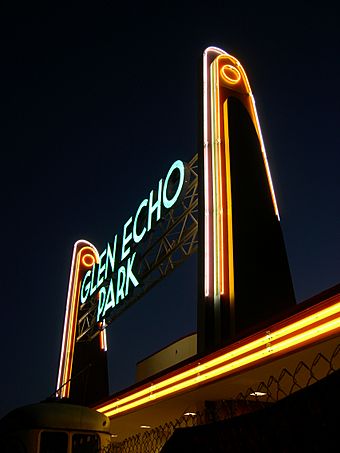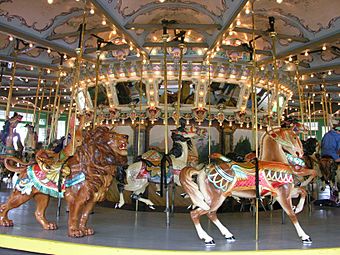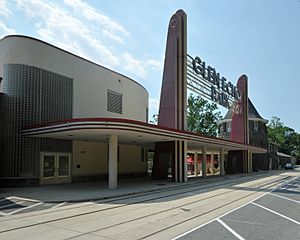Glen Echo Park, Maryland facts for kids
Quick facts for kids |
|
|
Glen Echo Park Historic District
|
|
 |
|
| Location | 7300 MacArthur Blvd. Glen Echo, Maryland |
|---|---|
| Area | 9 acres (3.6 ha) |
| Built | 1891 |
| Architect | Multiple |
| Architectural style | Moderne, Queen Anne, Shingle Style, Spanish Colonial Mission Revival |
| NRHP reference No. | 84001850 |
| Added to NRHP | June 8, 1984 |
Glen Echo Park is a lively arts and cultural center in Glen Echo, Maryland. It used to be a very popular amusement park near Washington, D.C. for many years, from the early 1900s to the late 1960s. The park today is named after that fun amusement park!
Glen Echo Park is about 9 miles (14 km) northwest of downtown Washington, D.C. It started in 1891 as a special learning and cultural center called a National Chautauqua Assembly. After some changes, it became Glen Echo Amusement Park in 1911. This park was open until 1968.
Today, Glen Echo Park is a very important cultural spot in the Washington, D.C. area. It offers many classes, workshops, and performances in art, music, and dance. People love its cool Art Deco buildings, an old Dentzel carousel, and a historic Spanish Ballroom. The park also has children's theaters, dance programs, and fun public events like Family Day and the Washington Folk Festival. More than 400,000 people visit the park each year! The National Park Service also gives tours about the park's history.
Contents
History of Glen Echo Park
The Chautauqua Idea
Two brothers, Edwin and Edward Baltzley, were inventors and real estate developers. They wanted to build a new community near the Potomac River. They imagined a clean, green place away from the busy city of Washington. To make their community special, they planned to add exciting attractions.
On February 24, 1891, the Baltzley brothers started the National Chautauqua of Glen Echo. This was a place for learning and culture. They quickly built a large stone building for their programs. It opened on June 16, 1891.
Their programs included talks and concerts in a huge amphitheater that could hold 6,000 people. They also offered classes in subjects like Bible studies and Greek. Famous people like John Philip Sousa and his band performed there. Clara Barton, who founded the American Red Cross, even had her home and the Red Cross headquarters at Glen Echo. She also helped lead the Chautauqua's women's committee. The first season was so successful that it lasted longer than planned!
Why the Chautauqua Failed
By the spring of 1892, the Baltzley brothers were in serious debt. They had borrowed a lot of money, using the Chautauqua site as a promise to pay it back. Other businesses they owned also had money problems. For example, their railroad company couldn't bring streetcar service to Glen Echo, which was a big disappointment.
To make things worse, a rumor spread in Washington that Glen Echo had malaria, a serious illness. Even if the rumor wasn't true, it scared people away. Because of these money troubles and bad rumors, the Chautauqua site was not used much anymore.
From Learning to Laughter: The Amusement Park Era
In the early 1900s, the Chautauqua site became an amusement park called Glen Echo Park. It was one of the biggest and most popular amusement parks in the Washington, D.C. area. It stayed very popular until the late 1940s.
However, by the mid-1950s, fewer people visited. This was partly because bigger theme parks, like Disneyland, were becoming popular. Another problem happened in 1960 when the trolley line from Washington, D.C. stopped running. This made it harder for people to get to the park. The amusement park kept going for a few more years, but it finally closed after the 1968 season.
A Time of Change: Ending Segregation
For many years, like many public places in the Washington area, Glen Echo Park only allowed white people to visit. This was called segregation.
On June 30, 1960, a group of college students, mostly from Howard University, decided to protest this unfair rule. They held a sit-in on the carousel. Five African American students were arrested for being there. Four years later, their arrests were reviewed by the Supreme Court. The Court decided that the state had unfairly used its power to help a private business keep its unfair rules.
This led to an eleven-week campaign against the park's rules. Students and people from the nearby community worked together to demand change. Because of their efforts, Glen Echo Park opened its doors to people of all races for the 1961 season. This was a big step forward for fairness and equality.
The Famous Carousel
|
Carousel at Glen Echo Park
|
|
|
U.S. Historic district
Contributing property |
|

Animals on the carousel
|
|
| Area | less than one acre |
|---|---|
| Built | 1921 |
| Architect | Dentzel, Gustav; Dentzel, William |
| Part of | Glen Echo Park Historic District (ID84001850) |
| NRHP reference No. | 80000351 |
| Significant dates | |
| Added to NRHP | July 4, 1980 |
| Designated CP | June 8, 1993 |
The last ride still working at the park, and a major highlight today, is a 1921 Dentzel menagerie carousel. It has 38 horses, 2 chariots, 4 rabbits, 4 ostriches, a lion, a tiger, a giraffe, and a prancing deer! A Wurlitzer style 165 Band Organ plays music for the carousel.
In the old days, brave riders could try to grab a "brass ring" from a holder next to the carousel. If you grabbed a brass ring, you won a free ride! The arm for the brass ring is still there, but it doesn't work anymore.
The carousel's look has changed a lot since 1921. The animals and other parts have been painted many times. When experts looked closely, they found many layers of paint from different years. The original 1921 paint was at the very bottom!
A special artist named Rosa Ragan restored the carousel. She found a way to uncover the original paint, record its colors and design, and then cover it with a special varnish. Then, she repainted the animals in their original colors. This way, the original paint is protected.
Ragan left a small spot of the original 1921 paint exposed on each animal. These spots are called "windows to the past." You can find them on the plain side (the side facing inward) of each animal. Her 20-year restoration made the carousel look beautiful and grand again!
The carousel was even in a movie! It appeared in the 1989 comedy Chances Are, starring Robert Downey Jr. and Cybill Shepherd. The carousel was added to the National Register of Historic Places in 1980.
New Beginnings: Managed by the National Park Service
Since 1971, Glen Echo Park has been part of the National Park Service. This means it's a special place protected by the government. With money from the government and donations, many parts of the park have been fixed up. This includes the beautiful Spanish Ballroom, the Arcade building (where art classes are now held), and the cool Art Deco style neon sign.
Glen Echo Park: An Arts and Cultural Center Today
Working Together: The Glen Echo Park Partnership
Glen Echo Park is now managed by the Glen Echo Park Partnership for Arts and Culture. They work with Montgomery County, Maryland and the National Park Service. The Partnership is a non-profit group started in 2002. Their job is to manage the park's art programs and buildings.
The Partnership wants to offer exciting art, culture, and educational activities at the park. They also want to make the park a special place for everyone in the area to visit. They work with artists and groups to create unique art programs. They also run the historic Dentzel carousel and the Spanish Ballroom. They organize many social dance programs, festivals, and special events. They also help raise money and keep the park's buildings in good shape.
Artists and Programs at the Park
Glen Echo Park is home to thirteen different artists and art groups. These artists and groups offer classes, concerts, art shows, and workshops. You can find places like:
- Adventure Theatre MTC (for theater)
- Art Glass Center at Glen Echo (for glass art)
- Glen Echo Pottery (for pottery)
- Photoworks (for photography)
- The Puppet Co. (for puppet shows)
- Washington Conservatory of Music (for music lessons)
- Yellow Barn Studio & Gallery (for painting and drawing)
Fun Events and Concerts
The park hosts many family festivals and special events all year long. Some of these include:
- Family Day (when the carousel opens for the season)
- Washington Folk Festival
- A Halloween dance with lots of decorations
- Winter's Eve
From June through August, the Glen Echo Park Partnership also puts on free summer concerts every Thursday night in the Bumper Car Pavilion.
Dancing at the Park
Glen Echo Park is a popular place for social dancing! They offer many dance events and classes. You can learn and dance styles like waltz, swing, contra, and salsa.
The dances happen in the beautiful historic Spanish Ballroom, the Bumper Car Pavilion, and a newer, climate-controlled room called the Ballroom Annex. About 60,000 people come to Glen Echo Park's dances every year!
The Spanish Ballroom had a big renovation in 2003 that cost $19 million. It now looks as grand as it did when it first opened. This makes it one of the best places for dancing in the Washington D.C. area. Before that, volunteers helped fix up the Bumper Car Pavilion, turning it into a great place for dancing in any weather. It's still used for dances and private events like weddings.
All social dances are open to everyone, no matter your age or if you have danced before. You don't even need a partner! Most dances offer a quick lesson before the main dance starts, and many have live music.
Images for kids
-
A PCC streetcar at the renovated Streamline Moderne entrance to Glen Echo Park (June 2006)
















